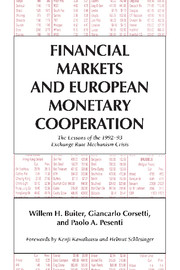 Financial Markets and European Monetary Cooperation
Financial Markets and European Monetary Cooperation Published online by Cambridge University Press: 06 July 2010
Since 1979, the Exchange Rate Mechanism (ERM) of the European Monetary System (EMS) has represented the cornerstone of monetary policy strategies in Europe and the most ambitious experiment in international monetary and exchange rate cooperation of the post-Bretton Woods era. Over the past decade, the nature of the ERM has changed drastically, from a system of fixed but adjustable rates with limited international capital mobility – as originally intended – to the “hard” mechanism implicitly ratified by the Basle-Nyborg agreement in 1987, characterized by stable and narrow target zones and the removal of capital controls.
By the end of the 1980s, the prima facie satisfactory performance of the “hard” ERM enhanced the general appeal of a further transformation of the system toward complete monetary harmonization and eventual unification. The successful conclusion of this transition was heralded as the permanent solution to the problem of inconsistency among national monetary policy objectives under free mobility of commodities, persons, and capital.
Starting in early 1992, however, a sequence of adverse developments of increasing severity seemed to compromise past achievements, as well as to undermine the process towards European Monetary Union (EMU). The crisis and revamping of the ERM between 1992 and 1993 represent the key events in the recent monetary history of Europe. Their origins, consequences, and implications are at the core of the current academic and political debate, both in Europe and elsewhere.
To save this book to your Kindle, first ensure [email protected] is added to your Approved Personal Document E-mail List under your Personal Document Settings on the Manage Your Content and Devices page of your Amazon account. Then enter the ‘name’ part of your Kindle email address below. Find out more about saving to your Kindle.
Note you can select to save to either the @free.kindle.com or @kindle.com variations. ‘@free.kindle.com’ emails are free but can only be saved to your device when it is connected to wi-fi. ‘@kindle.com’ emails can be delivered even when you are not connected to wi-fi, but note that service fees apply.
Find out more about the Kindle Personal Document Service.
To save content items to your account, please confirm that you agree to abide by our usage policies. If this is the first time you use this feature, you will be asked to authorise Cambridge Core to connect with your account. Find out more about saving content to Dropbox.
To save content items to your account, please confirm that you agree to abide by our usage policies. If this is the first time you use this feature, you will be asked to authorise Cambridge Core to connect with your account. Find out more about saving content to Google Drive.